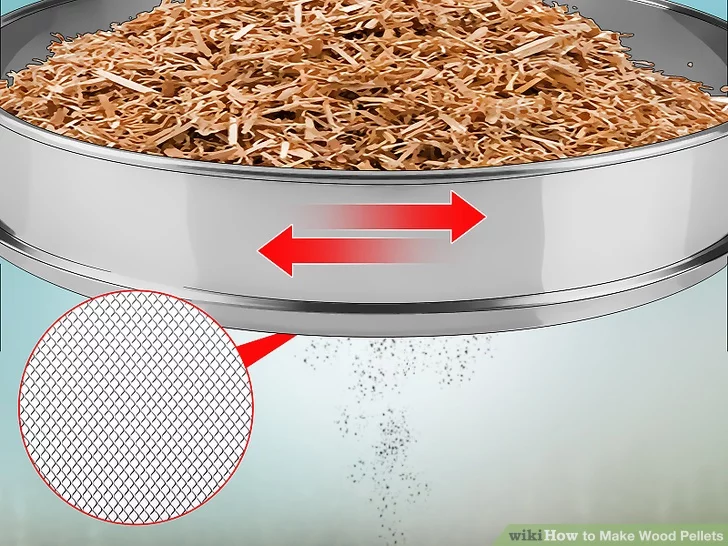 Wood pellets have emerged as a popular and sustainable alternative to traditional fossil fuels, providing efficient and clean energy. The primary source of wood pellets is derived from wood waste, including sawdust and other byproducts generated by lumber mills. This raw material is collected and processed meticulously to ensure its suitability for pellet production.
Wood pellets have emerged as a popular and sustainable alternative to traditional fossil fuels, providing efficient and clean energy. The primary source of wood pellets is derived from wood waste, including sawdust and other byproducts generated by lumber mills. This raw material is collected and processed meticulously to ensure its suitability for pellet production.
Lumber mills, which are responsible for processing timber into various wood products, generate substantial amounts of waste during their operations. This waste, in the form of sawdust, bark, and wood shavings, serves as a valuable resource for producing wood pellets. By utilizing this wood waste, the industry can significantly reduce its environmental impact.
The collection of wood waste begins within the lumber mills themselves. Sophisticated systems are employed to capture and gather the sawdust and other wood byproducts generated during the milling process. These systems utilize specialized equipment such as vacuum systems, cyclones, and filters to extract the waste materials.
Once collected, the wood waste undergoes a series of processing steps to prepare it for pellet production. The first step involves removing any impurities or contaminants from the raw material. This is achieved through a process called screening, where the wood waste is passed through screens of varying sizes to separate out larger particles and debris.
Following the screening process, the wood waste is dried to reduce its moisture content. Lowering the moisture content is crucial as it enhances the combustion efficiency and energy density of the resulting wood pellets. To achieve this, the collected waste is typically fed into large drying drums or kilns where hot air circulates, evaporating the moisture present in the material.
After the drying phase, the wood waste is finely ground into a consistent particle size. This grinding process ensures uniformity and improves the pelletizing efficiency. The resulting material, known as sawdust or wood fiber, is then ready for pellet production.
To produce high-quality wood pellets, the processed wood waste is further compressed under high pressure and temperature in pellet mills. The combination of heat and pressure causes the lignin, a natural polymer present in wood, to soften and bind the particles together, forming the characteristic shape of wood pellets. Once cooled, the pellets are then screened and graded to ensure uniformity in size and quality.
In conclusion, wood pellets are primarily derived from wood waste generated by lumber mills. Through a careful collection and processing process, including screening, drying, grinding, and pelletizing, the raw material is transformed into high-quality wood pellets. By utilizing this abundant and renewable resource, wood pellets offer a sustainable and environmentally friendly energy solution for both residential and industrial applications.
Grinding and Drying: Highlight the first steps in the manufacturing process, where the collected wood waste is ground into smaller particles and dried to reduce moisture content. Elaborate on the machinery and techniques used for grinding and the importance of proper drying to ensure the quality of the final product.
In the world of wood manufacturing, the process begins with the crucial steps of grinding and drying. These initial stages set the foundation for creating high-quality wood products, ensuring that the end result is both durable and aesthetically pleasing. Let’s delve into the intricacies of grinding and drying, exploring the machinery and techniques involved, as well as the significance of proper drying methods in achieving an exceptional final product.
Grinding is the first step in transforming the collected wood waste into smaller, more manageable particles. This process involves the use of specialized machinery, such as wood chippers or grinders, which shred the wood waste into consistent sizes. These machines employ sharp blades or hammers to break down the wood, reducing it to fragments that are easier to handle and process further.
The proper grinding technique is crucial to achieve uniformity in the resulting wood particles. A consistent size ensures that the subsequent manufacturing steps, such as pressing or extrusion, are executed smoothly and efficiently. Moreover, the particle size greatly influences the overall quality and appearance of the final product. Manufacturers must carefully select the grinding machinery and adjust its settings to obtain the desired particle size, whether it be fine particles for a smooth finish or coarser ones for a more rustic appeal.
After grinding, the wood particles undergo a vital process known as drying. The moisture content of the wood must be reduced to enhance its stability, strength, and usability in various applications. Proper drying eliminates excess moisture, preventing potential issues such as warping, cracking, or mold growth. Additionally, lower moisture content in the wood ensures that adhesives, paints, or stains applied later adhere effectively, enhancing the durability and aesthetics of the final product.
Various drying techniques are employed, depending on factors like the type of wood and desired moisture reduction. Air drying, a traditional method, involves stacking the wood particles outdoors and allowing natural air circulation to gradually evaporate moisture. However, this process can be time-consuming, and the weather’s impact may hinder its effectiveness. Therefore, many wood manufacturers opt for kiln drying, which utilizes specialized chambers to control temperature, humidity, and airflow. Kiln drying accelerates the process, reducing the wood’s moisture content efficiently and reliably.
Proper grinding and drying lay the foundation for a successful wood manufacturing journey. By utilizing specialized machinery and techniques, wood waste is transformed into manageable particles, ensuring uniformity and ease of further processing. The importance of correct drying techniques cannot be overstated, as they contribute to the stability, strength, and aesthetic appeal of the final wood products. Whether it’s fine furniture, sturdy flooring, or intricate woodwork, the journey begins with the meticulous steps of grinding and drying, ultimately leading to exceptional craftsmanship and customer satisfaction.
Pelletizing is a crucial stage in the production of wood pellets. This process involves compressing dried wood particles under high pressure to form small cylindrical pellets. The pelletizing process is instrumental in transforming loose wood particles into a compact and energy-dense form, making it easier to handle, transport, and utilize as a renewable energy source.
To begin the pelletizing process, dried wood particles are fed into pellet mills. These mills are specifically designed to apply both heat and pressure to the wood particles, causing them to bind together without the need for any additives. The heat generated during the pelletizing process softens the lignin within the wood, acting as a natural binder. As pressure is applied, the softened lignin adheres to the particles, creating solid and durable pellets.
The pellet mill consists of a die and rollers. The die contains small holes through which the wood particles pass, while the rollers exert the necessary pressure to compress the particles into pellets. As the wood particles are forced through the die, the high pressure and heat generated within the mill cause the lignin to melt, acting as a glue that binds the particles together upon cooling.
It is important to note that the pelletizing process requires precise control of key parameters, such as temperature, pressure, and moisture content. These variables influence the quality and characteristics of the final wood pellets. Additionally, the size of the die holes determines the diameter of the pellets, which can range from 6 to 8 millimeters for residential heating purposes. For industrial applications, pellets with larger diameters may be produced.
The use of pellet mills for pelletizing wood offers numerous advantages. Firstly, the compression of wood particles increases the energy density of the material, making it more efficient for storage and transportation. Moreover, the pelletizing process removes excess moisture from the wood, resulting in a stable and uniform product with a higher energy content. This, in turn, maximizes the combustion efficiency of wood pellets, reducing emissions and promoting cleaner energy.
In conclusion, pelletizing is a critical stage in the production of wood pellets. Through the use of pellet mills, the dried wood particles are compressed under high pressure and heat, allowing them to bind together naturally without the need for additives. This process transforms loose wood particles into compact and energy-dense pellets, facilitating their use as a sustainable and renewable energy source. The precise control of key parameters ensures the consistent quality and characteristics of the final product, making wood pellets an efficient and environmentally friendly alternative to traditional fuels.
Cooling and Screening:
After the wood pellets are formed, it is crucial to undergo a subsequent cooling process to stabilize their structure and ensure maximum quality. This cooling process brings the freshly formed pellets down to room temperature, preparing them for packaging and distribution.
Various methods are employed to cool the wood pellets effectively. One commonly used method is utilizing ambient air. The pellets are spread out in thin layers and exposed to the surrounding air, allowing natural convection to dissipate the heat. This method is cost-effective and energy-efficient, as it makes use of the existing environment. However, it may not always be suitable for large-scale production, as it can be time-consuming due to slower cooling rates.
Alternatively, dedicated cooling systems can be implemented to expedite the cooling process. These systems often utilize forced air or water cooling mechanisms. Forced air cooling involves blowing cool air over the pellets, rapidly reducing their temperature. On the other hand, water cooling immerses the pellets in a water bath, efficiently extracting the heat. These systems enable faster cooling rates, allowing for higher production volumes. However, they may require additional energy consumption and infrastructure investment.
In addition to cooling, screening the wood pellets is an essential step before packaging and distribution. This process involves removing any irregular or oversized pellets that may affect the quality and consistency of the final product. Screening is typically carried out using specialized equipment designed to separate the pellets based on size and shape.
Screening helps to ensure uniformity in pellet size, which is crucial for efficient combustion and consistent heat output. Oversized pellets may cause blockages or uneven burning, while irregular ones can result in inconsistent performance. By removing these pellets, the screening process guarantees that only high-quality, properly sized pellets move forward in the production line.
Moreover, screening also helps to eliminate any impurities or foreign objects that might have been introduced during the production or cooling stages. These impurities can include dust, debris, and other contaminants. By removing them, the screening process ensures that the final wood pellet product is clean and meets the required standards.
In conclusion, the cooling process is a vital stage in wood pellet production. It stabilizes the freshly formed pellets, allowing them to reach room temperature and be ready for packaging. Whether through ambient air or dedicated cooling systems, efficient cooling methods ensure the pellets’ quality and consistency. Additionally, screening the pellets removes any irregular or oversized ones, guaranteeing uniformity in size and eliminating impurities. By implementing these processes, manufacturers can deliver high-quality wood pellets that meet the demands of consumers and contribute to a sustainable energy future.



